|
|
|
Sort Order |
|
|
|
Items / Page
|
|
|
|
|
|
|
| Srl | Item |
| 1 |
ID:
129520
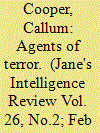

|
|
|
| 2 |
ID:
192077
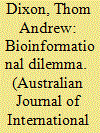

|
|
|
|
|
| Summary/Abstract |
Bioinformational diplomacy is a field of practice that emerges from the politics of biological information exchange during global public health emergencies. Cyberbiosecurity is a field of practice that emerges from the need to secure material at the interface of the digital and biological worlds from misuse and exploitation. Bioinformational diplomacy arises from the intersection of biologically-derived information becoming acutely valuable to national security actors, and the secrecy with which some valuable bioinformation is handled during global public health emergencies. This article analyses bioinformational diplomacy in relation to cyberbiosecurity and shows that both fields of practice are anchored by the concept of bioinformational secrecy. This paper explores the cooperative exchange and competitive exfiltration of bioinformation using the acute phase of the COVID-19 pandemic as a case study. During the COVID-19 pandemic, states sought to protect and covertly acquire certain types of bioinformation. This highlighted a potentially destabilising security dilemma that requires ongoing management via the practice of bioinformational diplomacy.
|
|
|
|
|
|
|
|
|
|
|
|
|
|
|
|
| 3 |
ID:
102725
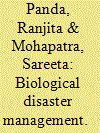

|
|
|
| 4 |
ID:
124636
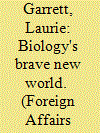

|
|
|
|
|
| Publication |
2013.
|
| Summary/Abstract |
In May 2010, the richest, most powerful man in biotechnology made a new creature. J. Craig Venter and his private-company team started with DNA and constructed a novel genetic sequence of more than one million coded bits of information known as nucleotides. Seven years earlier, Venter had been the first person in history to make a functioning creature from information. Looking at the strings of letters representing the DNA sequence for a virus called phi X174, which infects bacteria, he thought to himself, "I can assemble real DNA based on that computer information." And so he did, creating a virus based on the phi X174 genomic code. He followed the same recipe later on to generate the DNA for his larger and more sophisticated creature. Venter and his team figured out how to make an artificial bacterial cell, inserted their man-made DNA genome inside, and watched as the organic life form they had synthesized moved, ate, breathed, and replicated itself.
|
|
|
|
|
|
|
|
|
|
|
|
|
|
|
|
| 5 |
ID:
126033
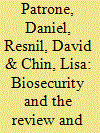

|
|
|
|
|
| Publication |
2012.
|
| Summary/Abstract |
Dual-use research of concern (DURC) is scientific research with significant potential for generating information that could be used to harm national security, the public health, or the environment. Editors responsible for journal policies and publication decisions play a vital role in ensuring that effective safeguards exist to cope with the risks of publishing scientific research with dual-use implications. We conducted an online survey of 127 chief editors of life science journals in 27 countries to examine their attitudes toward and experience with the review and publication of dual-use research of concern. Very few editors (11) had experience with biosecurity review, and no editor in our study reported having ever refused a submission on biosecurity grounds. Most respondents (74.8%) agreed that editors have a responsibility to consider biosecurity risks during the review process, but little consensus existed among editors on how to handle specific issues in the review and publication of research with potential dual-use implications. More work is needed to establish consensus on standards for the review and publication of dual-use research of concern in life science journals.
|
|
|
|
|
|
|
|
|
|
|
|
|
|
|
|
| 6 |
ID:
147322


|
|
|
|
|
| Summary/Abstract |
Biosecurity is a concern in many parts of the world but is differently conceived and addressed depending on context. This article draws on two cases concerned with life sciences research involving dangerous pathogens, one in the United States and one in Israel, to examine this variability. In both cases, concern revolves around issues of biosafety and bioterrorism, which are targeted by similar policies and solutions. The cases, nevertheless, differ. In the United States, biosecurity is contextualized in the dynamics between science and society, and apprehension about research with dangerous pathogens focuses on the social risks and benefits of such research. In Israel, biosecurity is contextualized in the dynamics between science and the state and hinges on whether and how far the state should restrict scientific freedom. In view of this difference, the authors advocate the development of a nuanced concept of biosecurity capable of describing and explaining local permutations. They suggest reconceptualizing biosecurity as a boundary object that mediates between competing domains and that takes variable form in efforts to resolve the problem of securing life.
|
|
|
|
|
|
|
|
|
|
|
|
|
|
|
|
| 7 |
ID:
126257


|
|
|
|
|
| Publication |
2012.
|
| Summary/Abstract |
Biosecurity measures are traditionally applied to laboratories, but they may also be usefully applied in highly specialized clinical settings, such as the isolation facilities for the management of patients with highly infectious diseases (eg, viral hemorrhagic fevers, SARS, smallpox, potentially severe pandemic flu, and MDR- and XDR-tuberculosis). In 2009 the European Network for Highly Infectious Diseases conducted a survey in 48 isolation facilities in 16 European countries to determine biosecurity measures for access control to the facility. Security personnel are present in 39 facilities (81%). In 35 facilities (73%), entrance to the isolation area is restricted; control methods include electronic keys, a PIN system, closed-circuit TV, and guards at the doors. In 25 facilities (52%), identification and registration of all staff entering and exiting the isolation area are required. Access control is used in most surveyed centers, but specific lacks exist in some facilities. Further data are needed to assess other biosecurity aspects, such as the security measures during the transportation of potentially contaminated materials and measures to address the risk of an "insider attack."
|
|
|
|
|
|
|
|
|
|
|
|
|
|
|
|
| 8 |
ID:
094414
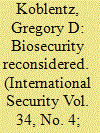

|
|
|
|
|
| Publication |
2010.
|
| Summary/Abstract |
Advances in science and technology, the rise of globalization, the emergence of new diseases, and the changing nature of conflict have increased the risks posed by naturally occurring and man-made biological threats. A growing acceptance of a broader definition of security since the end of the Cold War has facilitated the rise of biosecurity issues on the international security agenda. Developing strategies to counter biological threats is complicated by the lack of agreement on the definition of biosecurity, the diverse range of biological threats, and competing perspectives on the most pressing biological threats. A comprehensive definition of biosecurity that encompasses naturally occurring, accidental, and deliberate disease outbreaks can help to further research, analysis, and policymaking. Operationalizing this broad conception of biosecurity requires a taxonomy of biological threats based on a levels-of-analysis approach that identifies which types of actors are potential sources of biological threats and the groups most at risk from these threats. A biosecurity taxonomy can provide a common framework for the multidisciplinary research and analysis necessary to assess and manage these risks. It also has implications for how to prevent and respond to biological threats, as well as for the future of biosecurity research.
|
|
|
|
|
|
|
|
|
|
|
|
|
|
|
|
| 9 |
ID:
178323


|
|
|
|
|
| Summary/Abstract |
In the years following the Severe Acute Respiratory Syndrome (SARS) outbreak in 2002–2003, the World Health Organization (WHO) created a new system for global disease outbreak surveillance. The system relied on timely reporting by nation-states and gave the WHO a leading role in the global response. It also recognized the value of a multiplicity of sources of information, including from open-source media scanning. The post-SARS system faced its most significant task with the outbreak of the COVID-19 pandemic in the People’s Republic of China and its rapid spread in 2020. The WHO architecture for early warning of disease outbreaks arguably failed and gives rise to questions about how the international community can better respond to pandemic threats in future. This article explores the inter-connectedness of Canada’s system for global health surveillance, featuring the work of the Global Public Health Intelligence Network and that of the WHO, and argues that, while Canada has positioned itself as a global leader, much work needs to be done in Canada, and globally, if the concept of collective health security and shared early warning is to be maintained in the future.
|
|
|
|
|
|
|
|
|
|
|
|
|
|
|
|
| 10 |
ID:
182960
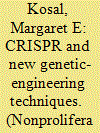

|
|
|
|
|
| Summary/Abstract |
This article explores the potential for new biotechnologically enabled weapons to compete with nuclear weapons in the context of strategic stability, assesses how such new technologies may affect assumptions in traditional strategic-stability models when applied to such scenarios, and how changing capabilities and adversaries may shape approaches to nonproliferation, verification, and monitoring. Among the most recent additions to the genome-editing arsenal is CRISPR (clustered regularly interspaced short palindromic repeats), a bacteria-derived system that is among the simplest genome-editing tools. The CRISPR-Cas9 system—and emerging variants of the system—enables unprecedented control and ease when editing the genome. With parallels to remote “command and control” of the genome, this aspect makes the technology different from earlier gene-editing methods. This article furthers the scholarly work on the biosecurity implications of CRISPR, gene editing, and broader issues of biotechnology by addressing these emerging life-science technologies in the context of nuclear strategic stability and implications for balance of power, nonproliferation, and international security.
|
|
|
|
|
|
|
|
|
|
|
|
|
|
|
|
| 11 |
ID:
196611


|
|
|
|
|
| Summary/Abstract |
The Covid-19 pandemic saw a surge in cyber attacks targeting pharmaceutical companies and research organisations working on vaccines and treatments for the virus. Such attacks raised concerns around the (in)security of bioinformation (e.g. genomic data, epidemiological data, biomedical data, and health data) and the potential cyberbio risks resulting from stealing, compromising, or exploiting it in hostile cyber operations. This article critically investigates threat discourses around bioinformation as presented in the newly emerging field of ‘cyberbiosecurity’. As introduced by scholarly literature in life sciences, cyberbiosecurity aims to understand and address cyber risks engendered by the digitisation of biology. Such risks include, for example, embedding malware in DNA, corrupting gene-sequencing, manipulating biomedical materials, stealing epidemiological data, or even developing biological weapons and spreading diseases. This article brings the discussion on cyberbiosecurity into the realms of International Relations and Security Studies by problematising the futuristic threat discourses co-producing this burgeoning field and the pre-emptive security measures it advocates, specifically in relation to bioinformation. It analyses how cyberbiosecurity as a concept and field of policy analysis influences the existing securitised governance of bioinformation, the global competition to control it, and the inequalities associated with its ownership and dissemination. As such, the article presents a critical intervention in current debates around the intersection between biological dangers and cyber threats and in the calls for ‘peculiar’ policy measures to defend against cyberbio risks in the ‘new normal’.
|
|
|
|
|
|
|
|
|
|
|
|
|
|
|
|
| 12 |
ID:
182965
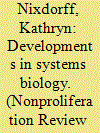

|
|
|
|
|
| Summary/Abstract |
Biological processes occur within complex, vital physiological systems. Systems biology seeks to understand how physiological systems function as a whole, integrating information about interactions in a biological system through computer-assisted modeling, aiming to identify relationships not found within individual biological units. Coupled with advances in the life sciences and computing power, this research is yielding an enormous amount of information about specific targets of vital physiological processes, and enabling predictions about how these targets may respond to a disturbance or change in signaling. This information can be greatly beneficial in treating complex diseases. It also has extended the spectrum of potential threat agents to include bioregulators, which to a great extent regulate the functioning of the nervous, endocrine, and immune systems. There is potential for misuse of the knowledge gained from these studies, and improved methods of targeted delivery of biochemicals make them more feasible weapons agents. Moreover, biochemical security concerns in systems biology are embedded within the larger domain of cyberbiosecurity. There remains a need for proactive approaches to the formulation of biochemical-security-oversight policy that would encompass developments at this interface of the life sciences and information technology.
|
|
|
|
|
|
|
|
|
|
|
|
|
|
|
|
| 13 |
ID:
182970
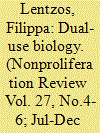

|
|
|
|
|
| Summary/Abstract |
At a time of heightened concern about potential future biological-weapons threats, this article considers how the international community can use the Biological and Toxin Weapons Convention framework to strengthen compliance monitoring of rapidly increasing dual-use capacities around the globe. It presents three conceptual layers within the treaty regime which states can draw from to inform their compliance judgments: one legally binding, one politically binding, and one wholly voluntary. The article outlines how these were established and how they have been used so far, and argues for an incremental, inclusive, practical, and forward-looking approach to evolving these structures to better manage perceptions of the intent behind dual-use capacities, and to further trust between states.
|
|
|
|
|
|
|
|
|
|
|
|
|
|
|
|
| 14 |
ID:
103485
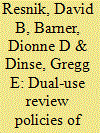

|
|
|
|
|
| Publication |
2011.
|
| Summary/Abstract |
To address biosecurity issues, government agencies, academic institutions, and professional societies have developed policies concerning the publication of "dual-use" biomedical research-that is, research that could be readily applied to cause significant harm to the public, the environment, or national security. We conducted an e-mail survey of life science journals to determine the percentage that have a dual-use policy. Of the 155 journals that responded to our survey (response rate 39%), only 7.7% stated that they had a written dual-use policy and only 5.8% said they had experience reviewing dual-use research in the past 5 years. Among the potential predictors we investigated, the one most highly associated with a journal having a written dual-use policy was membership in the Nature Publishing Group (positive association). When considered individually, both previous experience with reviewing dual-use research and the journal's impact factor appeared to be positively associated with having a written dual-use policy, but only the former remained significant after adjusting for publishing group. Although preventing the misuse of scientific research for terrorist or criminal purposes is an important concern, few biomedical journals have dual-use review policies. Journals that are likely to review research that raises potential dual-use concerns should consider developing dual-use policies.
|
|
|
|
|
|
|
|
|
|
|
|
|
|
|
|
| 15 |
ID:
182973
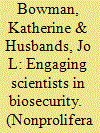

|
|
|
|
|
| Summary/Abstract |
Major efforts to engage scientists in issues of biosecurity in the United States and internationally began in the early 2000s in response to growing concerns about terrorists using weapons of mass destruction and the mailing of anthrax-laced letters in October 2001. This article draws on the literature about the “science of science communication,” including research on framing, to examine the strategies used to try to raise awareness and create support for policies and practices to address public concerns about biosecurity issues within scientific communities. Engagement strategies framed as an inherent part of the broader social responsibilities of the scientific community have shown the promise of being more effective than those framed in terms of legal and regulatory requirements and an emphasis on security alone. The article draws on the case of the InterAcademy Partnership (IAP), the global network of academies of science and medicine, and its relationship with the 1972 Biological and Toxin Weapons Convention (BWC), with additional examples from other national and international scientific organizations.
|
|
|
|
|
|
|
|
|
|
|
|
|
|
|
|
| 16 |
ID:
126123
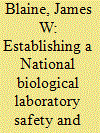

|
|
|
|
|
| Publication |
2012.
|
| Summary/Abstract |
The growing concern over the potential use of biological agents as weapons and the continuing work of the Biological Weapons Convention has promoted an interest in establishing national biological laboratory biosafety and biosecurity monitoring programs. The challenges and issues that should be considered by governments, or organizations, embarking on the creation of a biological laboratory biosafety and biosecurity monitoring program are discussed in this article. The discussion focuses on the following questions: Is there critical infrastructure support available? What should be the program focus? Who should be monitored? Who should do the monitoring? How extensive should the monitoring be? What standards and requirements should be used? What are the consequences if a laboratory does not meet the requirements or is not willing to comply? Would the program achieve the results intended? What are the program costs? The success of a monitoring program can depend on how the government, or organization, responds to these questions.
|
|
|
|
|
|
|
|
|
|
|
|
|
|
|
|
| 17 |
ID:
111694
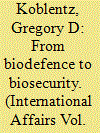

|
|
|
|
|
| Publication |
2012.
|
| Summary/Abstract |
The Seventh Review Conference of the Biological Weapons Convention (BWC), the first international treaty to outlaw an entire class of weapons, was held in Geneva in December 2011. On 7 December, Secretary of State Hillary Clinton became the highest-ranking US government official to address a BWC meeting. Secretary Clinton told the assembled delegation that 'we view the risk of bioweapons attack as both a serious national security challenge and a foreign policy priority'. At the same time, she warned that a large-scale disease outbreak 'could cripple an already fragile global economy'. Secretary Clinton's speech reflected a new understanding that the range of biological threats to international security has expanded from state-sponsored biological warfare programmes to include biological terrorism, dual-use research and naturally occurring infectious diseases such as pandemics. Recognizing these changes, President Barack Obama released a new national strategy for countering biological threats in 2009. This strategy represents a shift in thinking away from the George W. Bush administration's focus on biodefence, which emphasized preparing for and responding to biological weapon attacks, to the concept of biosecurity, which includes measures to prevent, prepare for and respond to naturally occurring and man-made biological threats. The Obama administration's biosecurity strategy seeks to reduce the global risk of naturally occurring and deliberate disease outbreaks through prevention, international cooperation, and maximizing synergies between health and security. The biosecurity strategy is closely aligned with the Obama administration's broader approach to foreign policy, which emphasizes the pragmatic use of smart power, multilateralism and engagement to further the national interest. This article describes the Obama administration's biosecurity strategy; highlights elements of continuity and change from the policies of the Bush administration; discusses how it fits into Obama's broader foreign policy agenda; and analyses critical issues that will have to be addressed in order to implement the strategy successfully.
|
|
|
|
|
|
|
|
|
|
|
|
|
|
|
|
| 18 |
ID:
119027
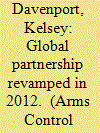

|
|
|
| 19 |
ID:
142652
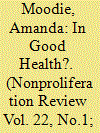

|
|
|
|
|
| Summary/Abstract |
Since the 1990s, the group of stakeholders working to combat biological weapons (BW) proliferation has broadened to include new actors who have not traditionally focused on security issues, including organizations from the public health sector, researchers in the life sciences, and the biosafety community. This has had significant benefits for the Biological and Toxin Weapons Convention (BWC) and the arms control establishment more broadly. However, the BWC's agenda has become increasingly dominated by issues of international health and global health security. By focusing solely on response strategies, the United States and other interested parties risk losing sight of other important elements of a counter-BW strategy, including deterrence and prevention. Focusing on public health-related issues to the exclusion of more traditional security matters puts the nonproliferation regime at risk, because it limits the amount of time that stakeholders have available to grapple with the critical questions facing the BWC and the biological weapons nonproliferation establishment—questions that must be answered if the regime is to survive.
|
|
|
|
|
|
|
|
|
|
|
|
|
|
|
|
| 20 |
ID:
109872


|
|
|
|
|
| Publication |
2012.
|
| Summary/Abstract |
For more than fifty years, the World Health Organization has helped monitor flu viruses and manufacture vaccines through the Global Influenza Surveillance Network (GISN). However, GISN became a flashpoint for conflict when Indonesia refused to share its samples of avian influenza until drugs and other benefits were shared in return. Years of controversial negotiations were required to agree on a framework for virus and benefit sharing, providing important insights into disease surveillance, global norms, and international law. First, this controversy suggests that surveillance behaves like a luxury good, which complicates the conventional wisdom that it is a global public good. Second, even well-established norms were not immune to challenge, thereby limiting the significance of 'tipping points' and 'normative cascades'. Finally, legal arguments were common in this controversy but equivocal and inconclusive, so international law is unlikely to affect important outcomes relating to outbreak response.
|
|
|
|
|
|
|
|
|
|
|
|
|
|
|
|
|
|
|
|
|